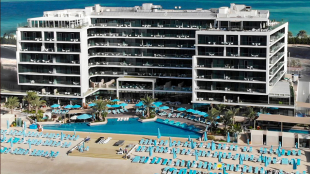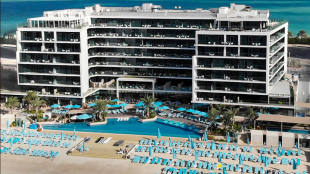
-
 Martin denies Bagnaia to win first MotoGP world championship
Martin denies Bagnaia to win first MotoGP world championship
-
Typhoon Man-yi weakens as it crosses Philippines' main island

-
 Noel wins season-opening slalom in Levi as Hirscher struggles
Noel wins season-opening slalom in Levi as Hirscher struggles
-
Tough questions for England as Springboks make it five defeats in a row

-
 Russia pounds Ukraine with 'massive' attack in 'hellish' night
Russia pounds Ukraine with 'massive' attack in 'hellish' night
-
McIlroy clinches Race to Dubai title with DP World Tour Championship win

-
 Glastonbury 2025 tickets sell out in 35 minutes
Glastonbury 2025 tickets sell out in 35 minutes
-
迪拜棕榈岛索菲特美憬阁酒店: 五星級健康綠洲

-
 The Retreat Palm Dubai MGallery by Sofitel: Пятизвездочный велнес-оазис
The Retreat Palm Dubai MGallery by Sofitel: Пятизвездочный велнес-оазис
-
New Zealand win revives France on their road to 2027 World Cup

-
 The Retreat Palm Dubai MGallery by Sofitel: A five-star wellness Oasis
The Retreat Palm Dubai MGallery by Sofitel: A five-star wellness Oasis
-
Israel hits Gaza and Lebanon in deadly strikes

-
 Power cuts as Russian missiles pound Ukraine's energy grid
Power cuts as Russian missiles pound Ukraine's energy grid
-
Denmark's Victoria Kjaer Theilvig crowned Miss Universe 2024

-
 Dutch police use hologram to try and decode sex worker's murder
Dutch police use hologram to try and decode sex worker's murder
-
Israel bombs south Beirut after Hezbollah targets Haifa area

-
 Biden in historic Amazon trip as Trump return sparks climate fears
Biden in historic Amazon trip as Trump return sparks climate fears
-
India hails 'historic' hypersonic missile test flight

-
 Israel orders Beirut residents to flee after Hezbollah targets Haifa area
Israel orders Beirut residents to flee after Hezbollah targets Haifa area
-
Davis, LeBron power Lakers over Pelicans as Celtics win in OT

-
 Trump and allies return to New York for UFC fights
Trump and allies return to New York for UFC fights
-
Hong Kong political freedoms in spotlight during bumper trial week

-
 Debt-saddled Laos struggles to tame rampant inflation
Debt-saddled Laos struggles to tame rampant inflation
-
Senna, Schumacher... Beganovic? Macau GP showcases future F1 stars

-
 India's vinyl revival finds its groove
India's vinyl revival finds its groove
-
G20 tests Brazil's clout in Lula 3.0 era

-
 Over 20,000 displaced by gang violence in Haiti: UN agency
Over 20,000 displaced by gang violence in Haiti: UN agency
-
Famed gymastics coach Bela Karolyi dies

-
 'Break taboos': Josep Borrell wraps up time as EU's top diplomat
'Break taboos': Josep Borrell wraps up time as EU's top diplomat
-
Climate finance can be hard sell, says aide to banks and PMs

-
 Trump revives 'peace through strength,' but meaning up to debate
Trump revives 'peace through strength,' but meaning up to debate
-
New York auction records expected for a Magritte... and a banana

-
 Egypt's middle class cuts costs as IMF-backed reforms take hold
Egypt's middle class cuts costs as IMF-backed reforms take hold
-
Beirut businesses struggle to stay afloat under Israeli raids

-
 Dupont lauds France 'pragmatism' in tight New Zealand win
Dupont lauds France 'pragmatism' in tight New Zealand win
-
Swiatek leads Poland into maiden BJK Cup semi-final

-
 Trump taps fracking magnate and climate skeptic as energy chief
Trump taps fracking magnate and climate skeptic as energy chief
-
West Indies restore pride with high-scoring win over England

-
 Hull clings to one-shot lead over Korda, Zhang at LPGA Annika
Hull clings to one-shot lead over Korda, Zhang at LPGA Annika
-
Xi tells Biden ready for 'smooth transition' to Trump

-
 Trump nominates fracking magnate and climate skeptic as energy secretary
Trump nominates fracking magnate and climate skeptic as energy secretary
-
Tyson says 'no regrets' over loss for fighting 'one last time'

-
 Springboks' Erasmus hails 'special' Kolbe after England try double
Springboks' Erasmus hails 'special' Kolbe after England try double
-
France edge out New Zealand in Test thriller

-
 Xi tells Biden will seek 'smooth transition' in US-China ties
Xi tells Biden will seek 'smooth transition' in US-China ties
-
Netherlands into Nations League quarter-finals as Germany hit seven

-
 Venezuela to free 225 detained in post-election unrest: source
Venezuela to free 225 detained in post-election unrest: source
-
Late Guirassy goal boosts Guinea in AFCON qualifying

-
 Biden arrives for final talks with Xi as Trump return looms
Biden arrives for final talks with Xi as Trump return looms
-
Dominant Sinner cruises into ATP Finals title decider with Fritz


Japan's 'megaquake' warning explained
Japan's earthquake scientists say the country should prepare for a possible "megaquake" one day that could kill hundreds of thousands of people -- although they stress the warning does not mean a colossal tremor is imminent.
The Japan Meteorological Association (JMA) warning is the first issued under new rules drawn up after a 2011 earthquake, tsunami and nuclear disaster killed around 18,500 people.
What does the warning say?
The JMA's "megaquake advisory" warns that "if a major earthquake were to occur in the future, strong shaking and large tsunamis would be generated".
"The likelihood of a new major earthquake is higher than normal, but this is not an indication that a major earthquake will definitely occur during a specific period of time," it added.
The advisory concerns the Nankai Trough "subduction zone" between two tectonic plates in the Pacific Ocean, where massive earthquakes have hit in the past.
What is the Nankai Trough?
The 800-kilometre (500-mile) undersea trough runs from Shizuoka, west of Tokyo, to the southern tip of Kyushu island.
It has been the site of destructive quakes of magnitude eight or nine every century or two.
These so-called "megathrust quakes", which often occur in pairs, have been known to unleash dangerous tsunamis along Japan's southern coast.
In 1707, all segments of the Nankai Trough ruptured at once, unleashing an earthquake that remains the nation's second-most powerful on record.
That quake -- which also triggered the last eruption of Mount Fuji -- was followed by two powerful Nankai megathrusts in 1854, and then a pair in 1944 and 1946.
How much is at stake?
Japan's government has previously said the next magnitude 8-9 megaquake along the Nankai Trough has a roughly 70 percent probability of striking within the next 30 years.
In the worst-case scenario 300,000 lives could be lost, experts estimate, with some engineers saying the damage could reach $13 trillion with infrastructure wiped out.
"The history of great earthquakes at Nankai is convincingly scary," geologists Kyle Bradley and Judith A Hubbard wrote in their Earthquake Insights newsletter.
And "while earthquake prediction is impossible, the occurrence of one earthquake usually does raise the likelihood of another", they explained.
"A future great Nankai earthquake is surely the most long-anticipated earthquake in history -- it is the original definition of the 'Big One'."
How worried should people be?
Japan is reminding people living in quake zones to take general precautions, from securing furniture to knowing the location of their nearest evacuation shelter.
Many households in the country also keep a disaster kit handy with bottled water, long-life food, a torch, radio and other practical items.
But there's no need to panic -- there is only a "small probability" that Thursday's magnitude 7.1 earthquake is a foreshock, according to Bradley and Hubbard.
"One of the challenges is that even when the risk of a second earthquake is elevated, it is still always low," they said.
"For instance, in California the rule of thumb is that any given earthquake has around five percent chance of being a foreshock."
K.Hill--AT


